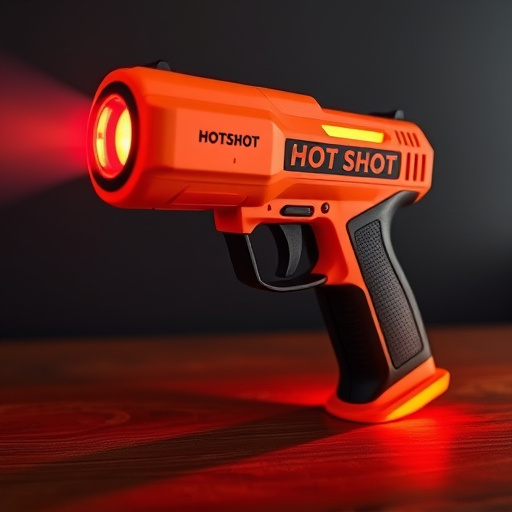Hot shot stun guns, legal in many US states, are subject to varying regulations dictating ownership, carry, and use. States like Texas and Florida treat them as non-lethal force options, while others like New York and California classify them as firearms. Background checks, permits, and specific voltage limits are common restrictions. Understanding state classifications is vital for responsible stun gun ownership and compliance with local laws.
“Unraveling the Complex Web of Stun Gun Laws: A State-by-State Guide
In today’s world, personal safety is paramount, and stun guns have emerged as a popular self-defense tool. However, navigating the legal landscape surrounding these devices can be a daunting task. This comprehensive guide aims to demystify stun gun regulations by providing an in-depth look at state-specific laws. From understanding the definitions and classifications to exploring variations in restrictions and permits for hot shot stun guns, we offer essential insights for prospective owners. Discover how to make informed decisions while ensuring compliance.”
- Understanding Stun Gun Laws: A Comprehensive Overview
- – Definition of stun guns and their purpose
- – State-by-state legal classification of stun guns
Understanding Stun Gun Laws: A Comprehensive Overview
Stun guns, also known as electroshock weapons or personal stun devices, are legal in many states across the US, but with varying restrictions and regulations. Understanding the legal landscape surrounding stun guns is essential for anyone considering purchasing one for self-defense purposes. Each state has its own set of laws dictating who can own a stun gun, where they can be carried, and under what circumstances. These regulations can differ significantly from state to state, making it crucial for individuals to familiarize themselves with the specific rules in their respective jurisdictions.
In many places, stun guns are treated similarly to firearms, requiring a background check, permit, or license for purchase and possession. Some states have specific classifications for stun devices, with certain power levels or voltage restrictions. For instance, some states may only allow low-voltage hot shot stun guns (typically 120,000 volts or less) while prohibiting more powerful models. Additionally, there might be rules about where these devices can be carried openly or concealed, and in what settings they are permitted, such as in public places, schools, or government buildings.
– Definition of stun guns and their purpose
Stun guns, also known as electronic control devices (ECDs), are non-lethal weapons designed to temporarily incapacitate a target through electric shock. These handheld devices emit a powerful electrical pulse that disrupts muscle control in the body, causing the individual to experience muscular paralysis and disorientation. Stun guns are often carried by individuals for self-defense purposes, providing a means of deterring potential attackers without resorting to lethal force. They have gained popularity as personal safety tools, especially among women and people who work or travel in potentially risky environments. With their compact size and non-lethal nature, stun guns like the hot shot stun gun offer users peace of mind and increased confidence in their ability to defend themselves.
The purpose of a stun gun extends beyond personal safety; it is also used by law enforcement agencies for crowd control and in situations where the use of deadly force may be inappropriate or excessive. The electric shock delivered by these devices is designed to be powerful enough to incapacitate an assailant temporarily, allowing users to escape or summon help. However, due to their non-lethal nature, stun guns are subject to various legal restrictions and regulations, which vary significantly from state to state in the US. Understanding these laws is crucial for anyone considering carrying a stun gun for self-defense or other purposes.
– State-by-state legal classification of stun guns
In the United States, the legal status of stun guns varies significantly from state to state, creating a patchwork of regulations that can be confusing for potential buyers. While some states allow open carry or concealment of stun guns without a permit, others have strict requirements, such as forcing owners to register their devices or obtain special licenses. The classification of stun guns as firearms or non-lethal self-defense tools plays a crucial role in these restrictions. For instance, Texas and Florida generally treat stun guns as less lethal force options, enabling open carry with minimal restrictions. Conversely, states like New York and California classify hot shot stun guns as firearms, subjecting them to more stringent rules, including permit requirements and limited public carrying.
Navigating these state-by-state legal classifications is essential for responsible stun gun ownership. Understanding the specific laws in your area ensures compliance with local regulations. Given the wide array of restrictions, individuals looking to purchase a hot shot stun gun should consult their state’s legislation or seek legal advice to ensure they make informed decisions about self-defense options that align with their rights and responsibilities.
When considering acquiring a hot shot stun gun, it’s crucial to understand the state-by-state legal landscape. While stun guns offer personal safety benefits, restrictions vary widely across the US. Navigating these laws ensures compliance and peace of mind. Remember that staying informed about your state’s regulations is essential for responsible stun gun ownership.
